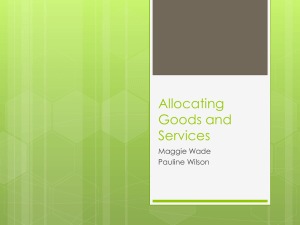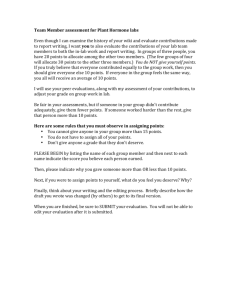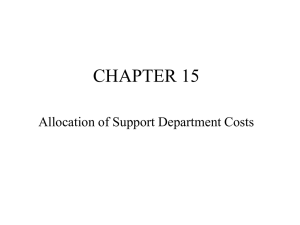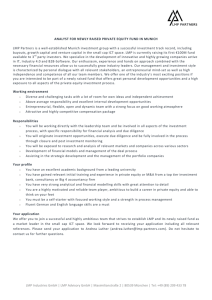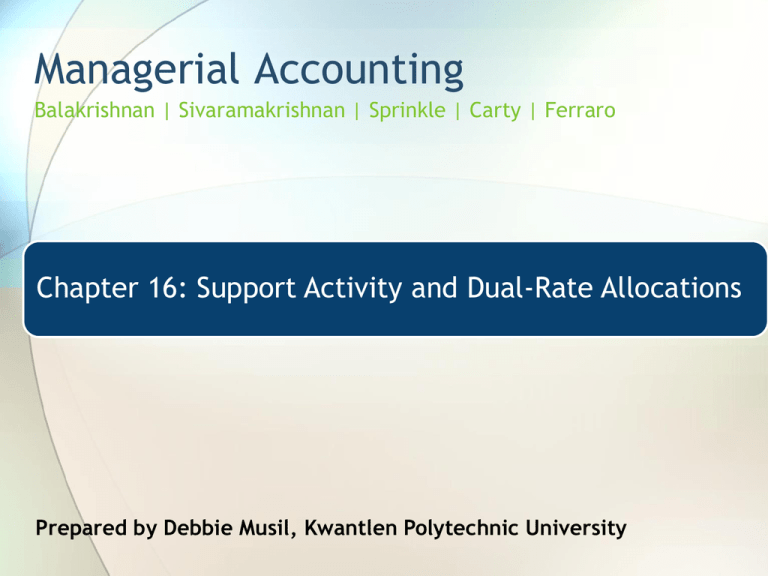
Managerial Accounting
Balakrishnan | Sivaramakrishnan | Sprinkle | Carty | Ferraro
Chapter 16: Support Activity and Dual-Rate Allocations
Prepared by Debbie Musil, Kwantlen Polytechnic University
Production & Support Activities
• A production activity is directly related to
producing services or products
− Costs are fully traceable to contracts undertaken
− Machining, assembly, sales
• A support activity is not directly related to
making or selling a product
− Needed to run the business (helps a line activity)
− Human resources, payroll
• Need to allocate costs of both line and staff
activities to products
LO1: Distinguish between line activities and support activities
What Is The Problem?
• Most allocations are two-stage systems
− Stage 1: Group costs into pools. Pools can be
departments, activities, etc.
− Stage 2: Identify cost drivers for each pool
• We have implicitly assumed a simple flow of
costs (i.e., assume line activities only)
− See following slide
• In reality, the pattern of resource consumption
could be complex (support activities exist)
− How should we account for this complexity in cost
flows?
LO1: Distinguish between line activities and support activities
A Simple Two-Stage Allocation
LO1: Distinguish between line activities and support activities
A Complex System
LO1: Distinguish between line activities and support activities
Available Options
• There are three methods that we could use
− Direct method
− Step-down method
− Reciprocal method
• Methods increase in accuracy from direct to
step-down to reciprocal
− The number of computations needed also increases
− Spreadsheets make step-down method easy to
implement
− Standard accounting software allows us to
implement the reciprocal method
LO2: Explain the three methods used to allocate the costs of support activities to products.
Data for Example
LO2: Explain the three methods used to allocate the costs of support activities to products.
Direct Method
• Simplifies allocation problem by ignoring work that
service departments do for one another
− Note that cost pools for primary activities only go
to the cost objects (by definition)
• Computation:
− Recalculate the consumption percentages ignoring
any consumption among support departments
− Allocate costs as before
LO2: Explain the three methods used to allocate the costs of support activities to products.
Direct Method
LO2: Explain the three methods used to allocate the costs of support activities to products.
Direct Method: Computations
LO2: Explain the three methods used to allocate the costs of support activities to products.
After eliminating consumption by administration, plumbing
consumes 42.5% ÷ 85.0% = 50% of the purchasing activity and
the Structural Department consumes 25.5% ÷ 85.0% = 30% of
the purchasing activity. Direct consumption by contracts
accounts for the remainder of 20%.
LO2: Explain the three methods used to allocate the costs of support activities to products.
The Step-Down Method
• Concept
− Partially considers reciprocity in consumption
− Rank the order of support departments per some
criterion (usually size)
− Allocate from S1 to all others (including S2, S3…)
− S2 cost now includes own cost plus cost allocated
from S1
− Allocate from S2 to remaining departments (S3,…)
− In this way, we close out one support pool at each
step
LO2: Explain the three methods used to allocate the costs of support activities to products.
Step-Down Method
LO2: Explain the three methods used to allocate the costs of support activities to products.
Step-Down Method: Computations
LO2: Explain the three methods used to allocate the costs of support activities to products.
Step-Down Method
• Also known as the sequential method
− Departments are sequentially allocated
• The ordering of support departments
matters
− Choice is often strategic as managerial
incentives are affected
− Affects consumption of allocated resource
• Attempt to minimize allocation
LO2: Explain the three methods used to allocate the costs of support activities to products.
Solution presented in next slide.
LO2: Explain the three methods used to allocate the costs of support activities to products.
Solution for Check It Exercise #2
• There is no need to revise the pattern for purchasing as we
allocate costs to all units that consume this activity. The revised
consumption pattern from administration = (28% ÷ 70%) = 40% for
plumbing and (14% ÷ 70%) = 20% for contracts.
• Costs allocated from purchasing are $37,500 (= 0.15 x $250,000) to
administration, $106,250 to plumbing, and $42,500 directly to
contracts. The total cost in administration is now $37,500 +
$650,000 = $687,500.
• From administration, we therefore allocate 0.40 x $687,500 =
$275,000 each to structural and plumbing, and 0.20 x $687,500 =
$137,500 directly to contracts. The final totals are $1,373,750 for
structural, $1,640,000 for plumbing, and $528,750 for contracts.
LO2: Explain the three methods used to allocate the costs of support activities to products.
The Reciprocal Method
• Conceptually most accurate
− Takes into account all work that departments do
for each other
• Views the allocation problem as a system of
equations
− Uses matrix algebra to solve
• Easily implemented with modern computer
packages
− Makes interpretation of rates quite hard, however
− The rate from S1 includes cost from S2, S3 etc,
each of which has costs from S1!
• This circularity has potential to confuse the casual user
LO2: Explain the three methods used to allocate the costs of support activities to products.
Mechanics
• Set up system of equations
− A = $650,000 + 0.10 P
− P = $250,000 + 0.30 A.
• Solve this system of equations by
substituting the second equation into the
first
− A = $719,895, P = $465,969
• Can use Excel for more complex systems
LO2: Explain the three methods used to allocate the costs of support activities to products.
Reciprocal Method: Computations
LO2: Explain the three methods used to allocate the costs of support activities to products.
Predetermined Overhead Rates
• Support allocations can be integrated with overhead
rates
• Suppose
− $719,895 allocated from admin cost pool under
reciprocal method
− SAC has 300 employees (incl. 8 in administration)
• Net 292 employees for the allocation
− Rate = $719,895 ÷ 292 = $2,465 per head
• Managers of the other line and support activities
would be charged $2,465 as the cost of administration
for each employee assigned to them
LO2: Explain the three methods used to allocate the costs of support activities to products.
Why Integrate?
• Helps sensitize managers that support
services are not free
• Provides incentives to control driver
quantity and thereby the allocated cost
− Try to make do with fewer employees
• The allocation is often seen as arbitrary
− Driver quantity and rate are often not controllable
− Lack of transparency in the system
• Why allocate $719,895 when cost is only
$650,000?
LO2: Explain the three methods used to allocate the costs of support activities to products.
Solution presented in next slide.
LO2: Explain the three methods used to allocate the costs of support activities to products.
Solution for Check It Exercise #3
Under the direct method, total cost is $250,000 (Exhibit 16.5)
and the denominator volume is 850 orders (1,050 - 50 for selfconsumption - 150 for administration). Thus, the rate per
order is $294.12 (rounded).
For the step-down method, the cost in the pool is $445,000
(Exhibit 16.7). Because we only allocate these costs to
structural, plumbing and contracts, the denominator volume
is 255 + 425 + 170 = 850 orders. Thus, the rate is $523.53 per
order (rounded).
The denominator volume for the reciprocal method is 1,000
orders (we include the 150 orders from administration as we
allocate costs back to administration). The rate is $465,968 ÷
1,000 orders = $465.97 per order.
LO2: Explain the three methods used to allocate the costs of support activities to products.
Dual-Rate Allocations
• Incorporates the cost hierarchy into the
allocations
• The cost pool for a department might contain
unit, batch, product and facility level costs
− Separate them into distinct pools and choose
suitable drivers
• In practice,
− Only two pools are made: Fixed and variable costs
− Variable costs allocated based on actual use
patterns
− Fixed (capacity) costs allocated based on long-term
use patterns
LO3: Discuss the need for dual-rate allocations
Example
• Total cost of printing = $125 × number of
prints
− But, if allocated at this rate, we might underutilize printing
− User-manager sees controllable cost as $125!
− But, only $50 per print might be controllable in
the short-term
• A better allocation
− $112,500 + $50 per actual print ordered
− $112,500 is a lump-sum allocation based on
long-term demand
− $50 per print is a variable cost incurred because
of transaction
LO3: Discuss the need for dual-rate allocations
Why Separate?
• Send clear signals re: the costs that are
controllable over differing time horizons
− Decisions regarding service use (which userdepartment managers control) based on
more relevant data
− Affects the amount of capacity to install
LO3: Discuss the need for dual-rate allocations
Exercise 16.21
Direct method (LO2).
The City of Pleasantville has two departments - Parks and Recreation
(P&R) and Facility Maintenance (FM) - that provide services to its
citizens. The P&R Department offers many programs in art, culture,
and athletics, while the FM Department maintains all of the streets,
buildings, and other public facilities. Behind the scenes, Pleasantville
has two departments that support the activities of the P&R and FM
departments. The Human Resources Department processes payroll
and oversees all hiring, development, and training. The General
Administration Department provides overall coordination and
managerial support.
The following table provides data regarding the consumption of
services by the various activity pools/departments, as well as the
amount of costs traced to each activity pool.
Exercise 16.21 (Continued)
Traced costs
Human
Resources
General
Administration
Parks and
Recreation
Facilities
Maintenance
$100,000
$60,000
$360,000
$450,000
Service consumption pattern
Services Consumed By
Human
Resources
Services
provided by
Human
Resources
General
Administration
20%
General
Administration
Parks and
Recreation
Facilities
Maintenance
40%
30%
30%
60%
20%
Required:
Allocate the costs of the two support departments to the line departments, using
the direct method. Compute the total costs in the cost pool for the P&R and FM
departments.
Exercise 16.21 (Continued)
The key idea in the direct allocation method is that we do not allocate
costs from one support department to another support department.
Thus, we could think of the direct method in two steps. First, compute
the allocation percentages, ignoring the services provided to other
support departments. Second, perform the allocations.
Exercise 16.21 (Continued)
In this exercise, we have two support departments: Human Resources
and General Administration. Thus, for step 1, we have:
Human
General
Resources Administration
Services
Provided
by
Parks and
Recreation
Facilities
Maintenance
Human
Resources1
50%
50%
General
Administration2
75%
25%
1
50% = (30/60) where 60 is the total of the support provided to non-servicepools/departments.
2
75% = (60/80) where 80 is the total of the support provided to non-service-
pools/departments; likewise for the FM department.
Exercise 16.21 (Concluded)
We can now perform the second step: allocate costs. We know that HR
has $100,000 and GA has $60,000 in costs. Thus, we have:
Costs
allocated
from
Human
Resources
General
Admin.
Parks and
Recreation
Facilities
Maintenance
Traced costs
$100,000
$60,000
$360,000
$450,000
Human
Resources1
(100,000)
50,000
50,000
(60,000)
45,000
15,000
0
$455,000
$515,000
General
Administration2
Total
0
50,000 = 0.50 × $100,000.
2 $45,000 = 0.75 × $60,000.
1
After the allocation, we have $455,000 in P&R and $515,000 in the FM
department. The total amount in these two pools is $970,000, the total
overhead that we began with for the four cost pools.
Copyright
Copyright © 2011 John Wiley & Sons Canada, Ltd. All rights reserved.
Reproduction or translation of this work beyond that permitted by
Access Copyright (the Canadian copyright licensing agency) is unlawful.
Requests for further information should be addressed to the
Permissions Department, John Wiley & Sons Canada, Ltd. The purchaser
may make back-up copies for his or her own use only and not for
distribution or resale. The author and the publisher assume no
responsibility for errors, omissions, or damages caused by the use of
these files or programs or from the use of the information contained
herein.

